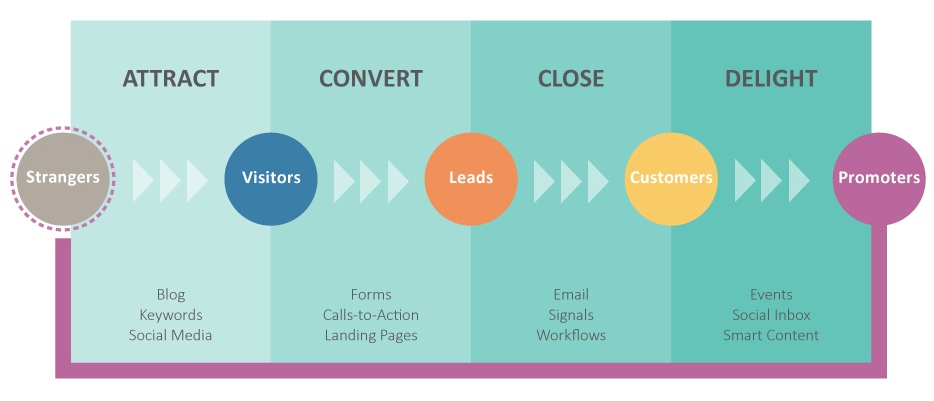Looking for free tools to turn you into a better inbound marketer? Then you've found the right...
Inbound marketing is constantly evolving. Here at Digital 22, we love keeping up with the new and exciting trends that develop every year. I’ve been doing my research, (and bugging some of my colleagues here in the office) to create a list of the most interesting inbound marketing trends that will be utilised in 2020.

Read on to find out more.
-
Using artificial intelligence tools for content, email and social
-
Utilising ephemeral and permanent content in social media marketing
-
Deliver what customers want, when they want, with personalisation
1. Video marketing: the next big thing
83% of marketers say that video gives them good ROI. With the consumption of video content being ever more prevalent, it’s no surprise that 50% of consumers say they want to see more video content from brands. We’re also big fans of utilising video as we create podcasts and interviews so you can keep up with the world of inbound.
Our Head of Creative, Paul, is a big advocate of video marketing:
 |
“I think video’s fantastic. It’s creative, unique and easily-shared - which is great for developing a message. Especially if your video goes viral. Like television, Netflix and Amazon Prime Video, people want binge-worthy content. But this doesn’t mean that written content is obsolete. They compliment each other greatly.”
|
You can incorporate video content through all parts of the flywheel. Video isn’t just for introducing a product. It can be used to supplement the customer service and sales effort your business undertakes.
Plus, video is increasingly accessible. With services such as HubSpot Video and Vidyard, literally anyone can utilise video content in their marketing efforts. All it takes is a smartphone and a little creative thinking.
2. Podcasts and episodic content
Podcasts come under the umbrella term that is ‘video.’ We film quite a lot of podcasts because, well, there’s a lot to say about inbound. One of our Director’s, Mark, is a big fan:
|
|
“Inbound marketing trends for 2020? For me, it’s episodic content. Our video partners Vidyard talk about this a lot. Episodic content is Netflix for marketers!”
|
An increasingly large number of businesses offer content in the form of podcasts. Innovative narratives, helpful tips and educational bites work incredibly well in a digestible visual format. Podcasts fit the genre of episodic content in that each one can easily focus on a small part of an overarching theme. They allow for collaboration with external partners.
Some benefits of creating podcasts include:
-
Podcasts are an easily-repeatable format.
-
Podcasts build following and anticipation.
-
Podcasts promote the overall series as a ‘whole,’ rather than random, unconnected videos.
-
Podcasts allow for helpful CTAs such as ‘subscribe’ buttons.
Why not check out one of our latest podcasts some of the guys did when they got back from INBOUND 19 in Boston?

3. Working with micro-influencers
Influencer marketing is still a pretty new thing, so don’t expect it to go anywhere. It’s here to stay. Because of social media and niche online communities, influencer marketing no longer has to focus on getting the big celebrity endorsement. The inbound marketing trend we want to focus on today is micro-influencer marketing.
With social media creating small, common and tight-knit communities - usually surrounding a fanbase or piece of popular culture - it’s common to see individual voices capitalising on those communities. Think of YouTubers who create content for specific fanbases such as gaming channels, makeup tutorials or even exercise routines.
If you can collaborate with a micro-influencer, you have a great chance of pushing your service or product onto the group of people who are most likely to purchase. Because of a micro-influencer’s higher level of engagement, their content is more likely to resonate with a larger amount of people.
Micro-influencers play a big part in converting leads, connecting audiences and boosting your brand awareness.
4. Inbound marketing for mobile
What do they tell us when we’re in the cinema, waiting for the film to begin? “Switch off your phone.” Well, sorry Vue, we’re here to tell you the opposite.
Everyone uses their phone at some part of the research journey today. 48% of consumers start their search engine research using a mobile device. If you’re on the go, at a work meeting or even travelling, your phone is your go-to device for information (provided you have data).
Because of this, it makes complete sense that a business’ website is optimised for mobile devices. You want to work with a marketing agency that knows how to design websites that can be easily accessed and read from any smartphone.
So if you’re marketing for a big cinema chain, it might be worth telling your customers to keep their phones switched on - maybe just put them on silent when the film starts to play.
5. Using artificial intelligence tools for content, email and social
Artificial Intelligence (AI) is the marketing tool of the future. It helps our software to work better and our content to sound more, well, human. We can use specific tools to develop cognitive content hubs which help us carry out a number of tasks, such as:
-
Analyse existing content for gaps and opportunities.
-
Choose keywords and topics for content optimisation.
-
Construct better buyer personas (based on goals, intent and actual site behaviour).
-
Uncover content insights for top performing campaigns.
-
Predict content performance before going live.
-
Recommend highly personalised content to users in real time.
After attending a few illuminating talks at INBOUND 19, our Head of Marketing, Andrew, got to grips with some new AI software that helps marketing agencies create bespoke content.
 |
“AI tools have been around, in theory, for quite some time. However, it's only now that I'm seeing tools I genuinely believe could help marketers save time and be more successful. Instead of trying to concoct the perfect subject line, blog title or content idea, marketers have the opportunity for AI tools like Phrasee to predict the best version of these, based on data, instantaneously. This is exciting to me as we can now focus our time on more creative and strategic endeavours whilst also improving the nuts and bolts of digital conversion quickly.” |
Three pieces of software really grabbed Andrew’s attention:
- Phrasee - Phrasee uses Natural Language Generation (NGL) to produce subject lines, Ad copy and page headlines that match your brand’s tone.
- PathFactory - PathFactory creates micro-personalised content recommendations anywhere on your website, deploying your best and most relevant content quickly.
- Persado - Persado breaks down your copy to give insight on increasing emotional appeal and the overall effectiveness of your content.
Utilising AI in specific steps of your marketing campaigns is a great time-saving idea. By handling smaller, easier tasks, you’ll be able to focus on the more vital, bigger picture stuff such as reporting, monitoring campaign success and managing client accounts. You’ll even have more time to build on your own inbound knowledge skills.
6. Utilising ephemeral and permanent content in social media marketing
There are two types of social media content you’ll want to use in 2020: ephemeral and permanent.
Ephemeral content
Ephemeral content is stuff that doesn’t last. Facebook and Instagram Stories, for example, make creating small pieces of photographic and video content easy. These ‘Stories’ will then only last for 24 hours before being deleted.
Using ephemeral content depends on the audience you are marketing to. It’s dictated heavily by which platform you’re using, as well as how your audience likes to interact. Using ephemeral content can keep your social media ticking away with new content that doesn’t have to be incredibly well-crafted or researched - it’s meant to be ad hoc, spontaneous and fun.
Permanent Content
In contrast to ephemeral content, permanent content is, well, permanent. It includes the main things you post to your Facebook and Instagram accounts. Your permanent content is what you can use to structure your social media presence, react to market trends and create a narrative for your brand.
Ephemeral content is used on top of permanent content to supplement your main posts. Combining these two showcases your brand’s voice and provides two ways to delight and inform customers about the goings-on in the world of your brand.
7. Engage an audience with interactive content
What’s even more engaging than top-quality content? Top-quality interactive content.
Consumers want new experiences when they use the internet and interactive content can grant those experiences. It draws visitors in, keeps them on your page longer and is also incredibly shareable. All these things add up to become a real contender for the future of content marketing.
In fact, interactive content can help increase your leads by up to 47%.
8. Deliver what customers want, when they want, with personalisation
Personalisation is about creating a customised website experience. It’s much more effective than a static page because it gives them what they want, when they want it.
At Digital 22, we like to deliver content where it will be the most effective. For example, there’s no point asking a person what kind of coffee they want after you’ve made a cappuccino. By providing relevant content specific to the stage they’re at, you’ll maximise your chances of turning that lead into a customer.
Use personalisation to deliver a personal experience that speaks to the hearts of visitors.
So if they want a macchiato, they can have one. Skinny latte? You got it. White mocha venti caramel frappuccino with hazelnut syrup and one shot of affogato? Whatever floats your inbound boat.
Now, keeping that inbound boat afloat requires a good amount of effort. You’ve got to stay on top of the latest ideas and technologies to achieve results. An agency can help you do that. If you’re interested in testing how these trends could help your business, but you’re not sure about the timeframes involved, look no further...
See how inbound can affect your business over 12 months
We’ve created ‘A Year in Inbound.’ With this guide, you can see how working with an inbound marketing agency such as Digital 22 can change your marketing campaigns for the better.
In it, you’ll find information on strategies, content creation, when you’ll start to see results and much more.
Click the link below to download.



